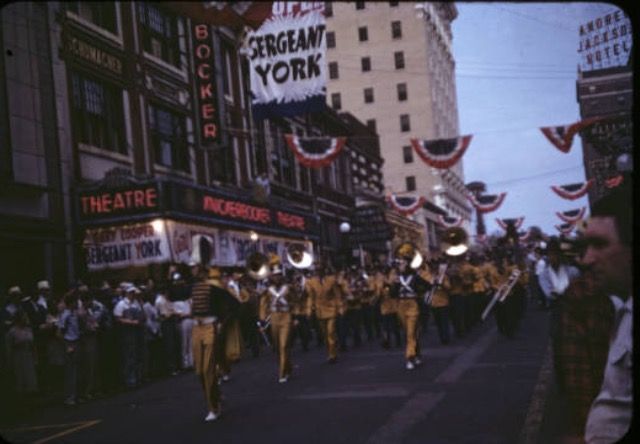Thursday 18 September 1941
 |
| "Sergeant York" starring Gary Cooper opens at the Knickerbocker Theatre in Nashville, Tennessee on 18 September 1941. |
 |
| A German signaller in the Aegean on 18 September 1941 (Federal Archive Picture 134-C0870). |
After dark, RAF Bomber Command sends 55 Wellingtons to bomb Karlsruhe. It is a dark night, however, and only 37 bombers can find the target, and their accuracy is poor. Another 10 Wellington bombers attack Le Havre without loss.
 |
| Focke Wulf Fw 190A WNr 50046 ca. 1941. |
The air war over the Continent is slowly picking up, but it can fairly be called about even between the two sides at this point. The appearance of a completely new Axis fighter comes as a complete surprise to the British. They desperately want to get one of the new planes to test, but that does not happen until June 1942.
 |
| Italian and German troops abandoning the Italian troopship Oceania as she sinks after being torpedoed by HMS Upholder, 18 September 1941. |
Battle of the Mediterranean: HMS Upholder (Lieutenant-Commander Malcolm David Wanklyn) torpedoes and sinks 19,425-ton Italian transport Neptunia and 19,507-ton Italian transport Oceania en route from Taranto to Tripoli. Mv Neptunia is sunk by one torpedo after the convoy was given away by intercepted messages. Due to this naval intelligence, the Royal Navy sent four submarines to intercept this heavily guarded convoy. Hours after sinking Neptunia, Wanklyn also torpedoes Oceania once and heavily damages it. The Italians take Oceania in tow, but Wanklyn then his the transport with two more torpedoes, causing it to sink in the evening.
Thus, these two sister ships are sunk within hours of each other by the same British submarine. The sinking set in motion a massive rescue operation. Pessagno, a destroyer whose normal complement was about 250 men, crammed aboard 2,083 survivors, while destroyer Da Recco (the escort leader) rescued 1,302 men; Da Noli, Gioberti and Usodimare picked up 682, 582, and 485 men, respectively. More survivors were rescued by the torpedo boats Clio (163), Perseo (131), and Circe (three) and by floatplanes (three). The combined losses are 384 men killed, 5434 men saved
 |
| The pier at Reval (Tallinn), Estonia, 18 September 1941 (Federal Archive Picture 146-2004-224). |
September 1941
September 1, 1941: Two Years In
September 2, 1941: Germans Pushed Back at Yelnya
September 3, 1941: FDR Refuses to Meet with Japanese
September 4, 1941: Hitler Furious at Guderian
September 5, 1941: Germans Evacuate Yelnya
September 6, 1941: Japan Prepares for War
September 7, 1941: Hitler Orders Drive on Moscow
September 8, 1941: Leningrad Cut Off
September 9, 1941: Germans Attack Leningrad
September 10, 1941: Guderian Busts Loose
September 11, 1941: Convoy SC-42 Destruction
September 12, 1941: Starve Leningrad!
September 13, 1941: Zhukov at Leningrad
September 14, 1941: Germany's Growing Casualties
September 15, 1941: Sorge Warns Stalin Again
September 16, 1941: Soviets Encircled at Kiev
September 17, 1941: Iran Conquest Completed
September 18, 1941: Focke-Wulf Fw 190 in Action
September 19, 1941: Germans Take Kiev
September 20, 1941: Death at Kiev
September 21, 1941: Raging Soviet Paranoia
September 22, 1941: Defense of Nickel Mines
September 23, 1941: Air Attacks on Leningrad
September 24, 1941: Japanese Spying Intensifies
September 25, 1941: Manstein at the Crimea
September 26, 1941: Kiev Pocket Eliminated
September 27, 1941: Massacre at Eišiškės
September 28, 1941: Ted Williams Hits .400
September 29, 1941: Babi Yar Massacre
September 30, 1941: Operation Typhoon Begins
2020
No comments:
Post a Comment